1993 PONTIAC BONNEVILLE fuel
[x] Cancel search: fuelPage 110 of 322
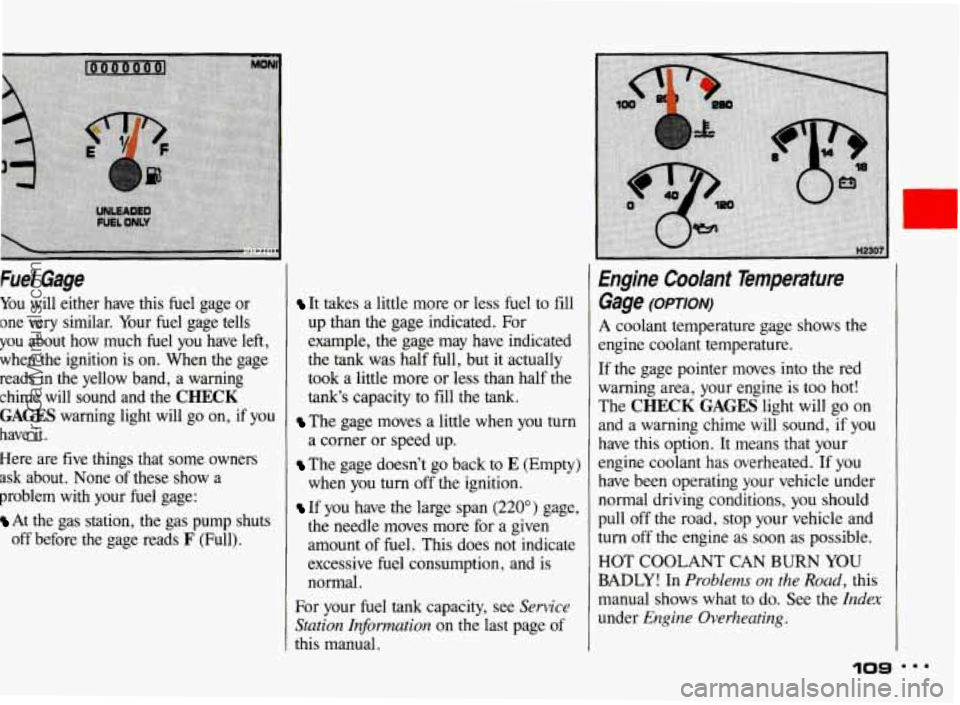
Fuel Gage
You will either have this fuel gage or
one very similar. Your fuel gage tells
you about how much fuel you have left,
when
the ignition is on. When the gage
reads in the yellow band, a warning
chime will sound and the
CHECK
GAGES warning light will go on, if you
have it.
Here are five things that some owners
ask about. None of these show a
problem with your fuel gage:
At the gas station, the gas pump shuts
off before the gage reads
F (Full).
It takes a little more or less fuel to fill
up than the gage indicated. For
example, the gage may have indicated
the
tank was half full, but it actually
took a little more or less than half the
tank's capacity to fill the tank.
The gage moves a little when you turn
a corner or speed up.
The gage doesn't go back to E (Empty)
when you turn off the ignition.
If you have the large span (220") gage,
the needle moves more for a given
amount
of fuel. This does not indicate
excessive fuel consumption, and is
normal.
For your fuel
tank capacity, see Sewice
Station Informution
on the last page of
this manual.
Engine Coolant Temperature
Gage
(OPTION)
A coolant temperature gage shows the
engine coolant temperature.
If the gage pointer moves into the red
warning area, your engine is too hot!
The
CHECK GAGES light will go on
and a warning chime will sound, if you
have this option. It means that your
engine coolant has overheated. If you
have been operating your vehicle under
normal driving conditions, you should
pull off the road, stop your vehicle and
turn off
the engine as soon as possible.
HOT COOLANT CAN
BURN YOU
BADLY! In Problems on the Road, this
manual shows what to do. See the
Index
under Engine Overheating.
10s
ProCarManuals.com
Page 112 of 322
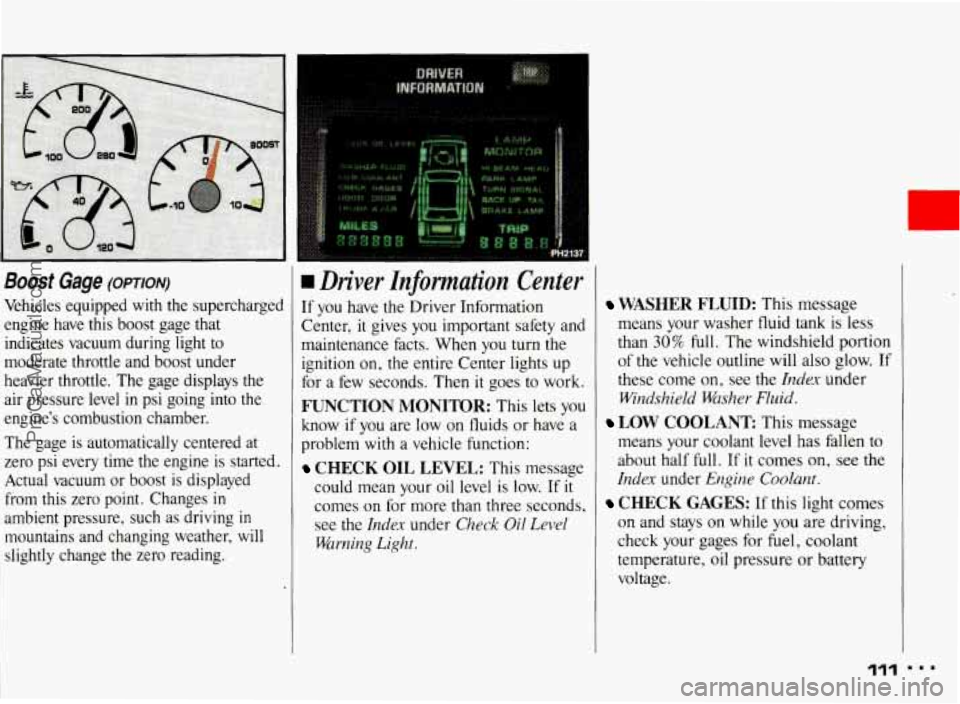
Boost Gage (OPTION)
Vehicles equipped with the supercharged
engine have this boost gage that indicates vacuum during light to
moderate throttle and boost under
heavier throttle. The gage displays the
air pressure level
in psi going into the
engine’s combustion chamber.
The gage is automatically centered at
zero psi
every time the engine is started.
Actual vacuum or boost
is displayed
from this zero point. Changes
in
ambient pressure, such as driving in
mountains and changing weather, will slightly change
the zero reading.
I
rn Driver Znformation Center
If you have the Driver Information
Center, it gives you important safety and
maintenance facts. When you turn the ignition on, the entire Center lights up
for a few seconds. Then it goes to work.
FUNCTION MONITOR: This lets you
know if you are low
on fluids or have a
problem with a vehicle function:
CHECK OIL LEVEL: This message
could mean your oil level is low. If
it
comes on for more than three seconds, see
the Index under Check Oil Level
Warning Light.
WASHER FLUID: This message
means your washer fluid tank is less
than
30% full. The windshield portion
of the vehicle outline will also glow. If
these come on, see the
Index under
Windshield Washer Fluid.
means your coolant level has fallen to
about half full. If it comes on,
see the
Index under Engine Coolant.
CHECK GAGES: If this light comes
on and stays on while
you are driving,
check your gages for fuel, coolant
temperature, oil pressure or battery
voltage.
LOW COOLANT This message
111
ProCarManuals.com
Page 117 of 322
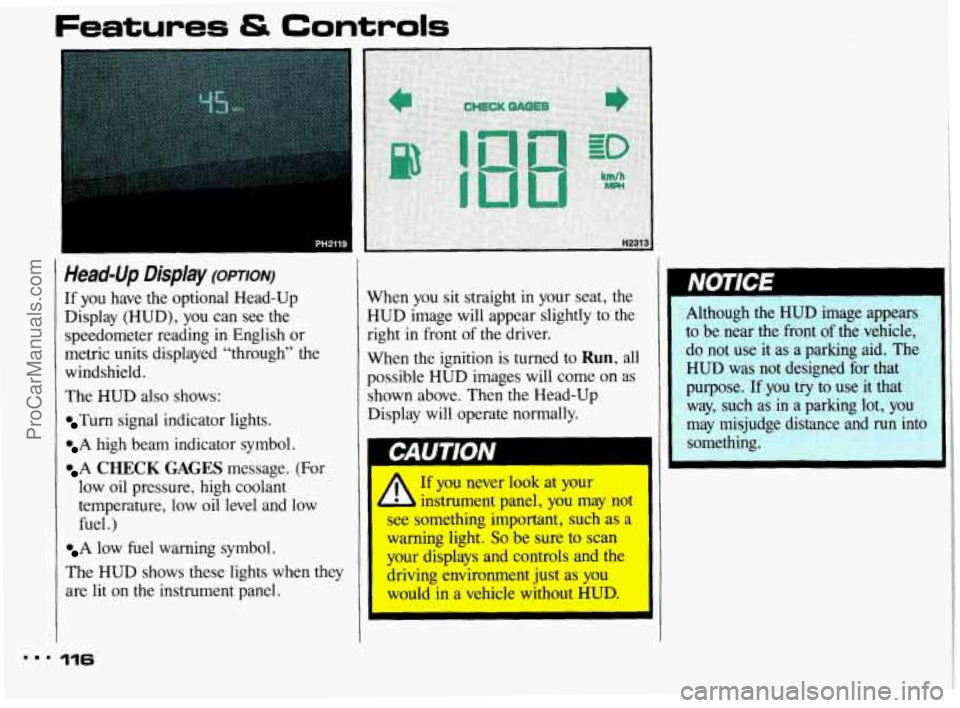
Features & Controls
pH2119
Head-Up Display (omorq
If you have the optional Head-Up
Display (HUD), you can see the
speedometer reading in English or
metric units displayed “through” the
windshield.
The HUD
also shows:
Turn signal indicator lights.
A high beam indicator symbol.
A CHECK GAGES message. (For
low oil pressure, high coolant
temperature, low oil level and low
fuel .)
A low fuel warning symbol.
The HUD shows these lights when they
are lit
on the instrument panel.
... 116
When you sit straight in your seat, the
HUD image will appear slightly to the
right in front
of the driver.
When the ignition is turned
to Run, all
possible HUD images will come on as
shown above. Then the Head-Up
Display will operate normally.
14
NOTEE
Although the HUD image appears
to be near the front
of the vehicle,
do not use it as a parking aid. The
HUD was not designed
for that
purpose.
If you try to use it that
way, such as in a parking lot,
you
may misjudge distance and run into
something.
If you never look at your
b instrument panel, you may not
see something important, such as a
warning light. So be sure to scan
your displays and controls and the
driving environment just
as you
would in a vehicle without
HUD.
ProCarManuals.com
Page 121 of 322
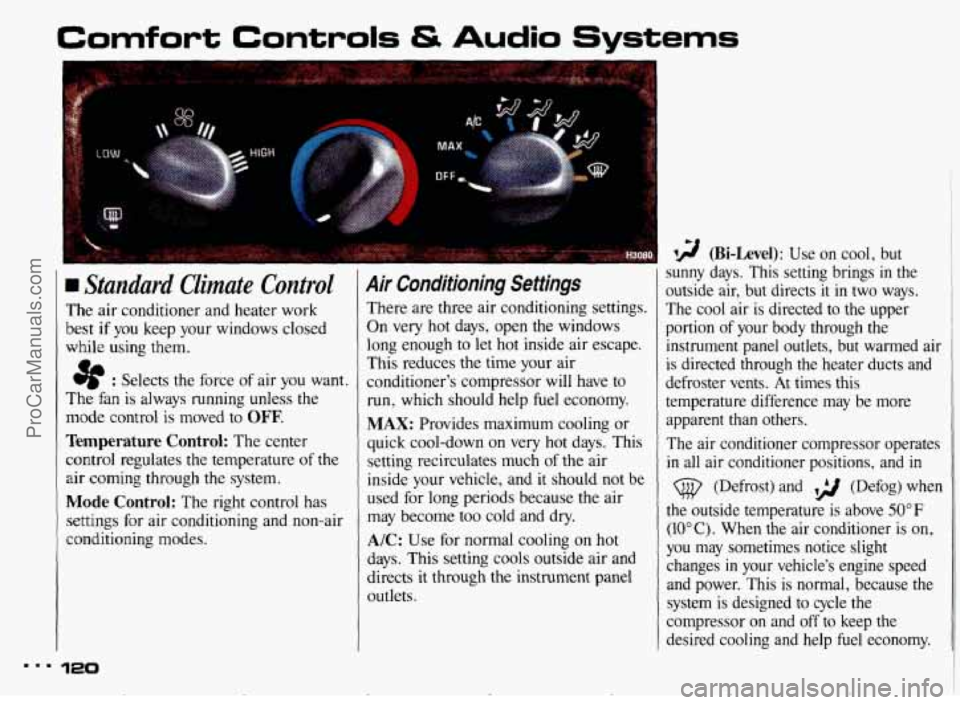
Comfort Controls & Audio Systems ~ ~~
I
Standard Climate Control
The air conditioner and heater work
best
if you keep your windows closed
while using them.
e : Selects the force of air you want.
The fan is always running unless the
mode control
is moved to OFF.
Temperature Control: The center
control regulates the temperature
of the
air coming through the system.
Mode Control: The right control has
settings for air conditioning and non-air
conditioning modes.
120
Air Conditioning Settings
There are three air conditioning settings.
On very hot days, open the windows
long enough to let hot inside air escape.
This reduces the time your air
conditioner's compressor
will have to
run, which should help fuel economy.
MAX: Provides maximum cooling or
quick cool-down on very hot days. This
setting recirculates much
of the air
inside your vehicle, and it should not be
used for long periods because
the air
may become too cold and dry.
A/C: Use for normal cooling on hot
days. This setting cools outside air and
directs it through the instrument panel
outlets.
I 9 (Bi-Level): Use on cool, but
sunny days. This setting brings
in the
outside air, but directs
it in two ways.
The cool air
is directed to the upper
portion
of your body through the
instrument panel outlets, but warmed air
1
is directed through the heater ducts and ~
defroster vents. At times this
temperature difference may be more
apparent than others.
The air conditioner compressor operates
in all air conditioner positions, and in
(@ (Defrost) and ,> (Defog) when
the outside temperature is above 50°F
(IOOC). When the air conditioner is on,
you may sometimes notice slight
changes
in your vehicle's engine speed
and power. This is normal, because the system
is designed to cycle the
compressor on and off to keep the
desired cooling and help fuel economy.
I
c ProCarManuals.com
Page 122 of 322
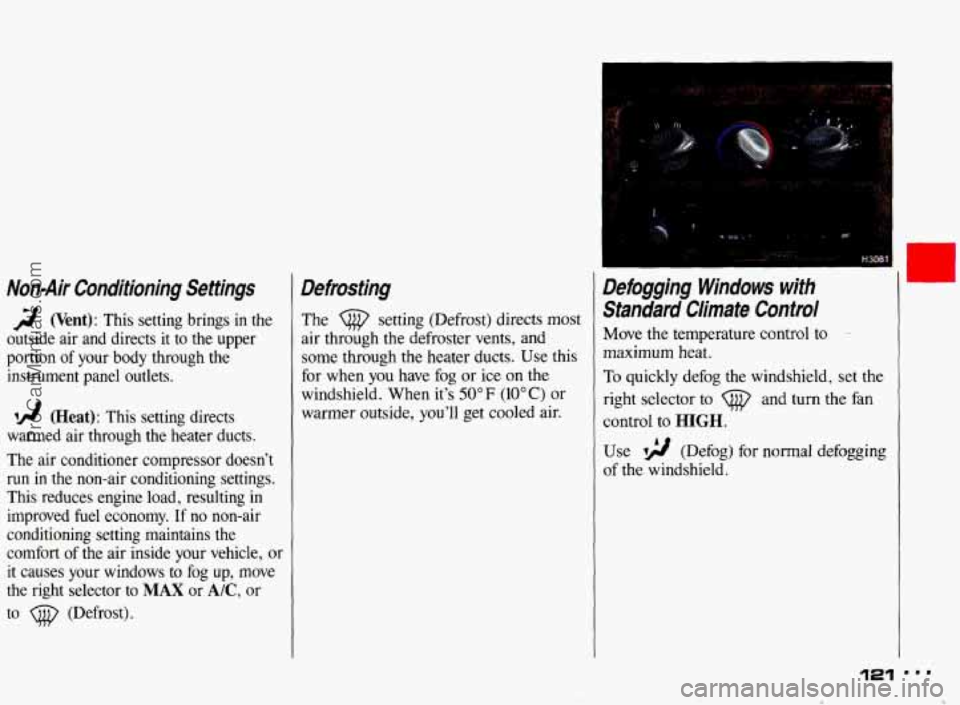
Non-Air Conditioning Settings
2 (Vent): This setting brings in the
outside air and directs it to the upper
portion of your body through the
instrument panel outlets.
A! (Heat): This setting directs
warmed air through the heater ducts.
The air conditioner compressor doesn’t
run in the non-air conditioning settings.
This reduces engine load, resulting in
improved fuel economy. If no non-air
conditioning setting maintains the
comfort of the air inside your vehicle, or
it causes your windows to fog
up, move
the right selector to
MAX or A/C, or
to
(@ (Defrost).
Defrosting
The setting (Defrost) directs most
air through the defroster vents, and
some through the heater ducts. Use this
for when you have fog or ice on the
windshield. When it’s
50°F (10°C) or
warmer outside, you’ll get cooled air.
Defogging Windows with
Standard Climate Control
Move the temperature control to --
maximum heat.
To quickly defog the windshield, set the
right selector to
(@ and turn the fan
control to
HIGH.
Use ~2 (Defog) for normal defogging
of the windshield.
U
121 smm
* ProCarManuals.com
Page 124 of 322
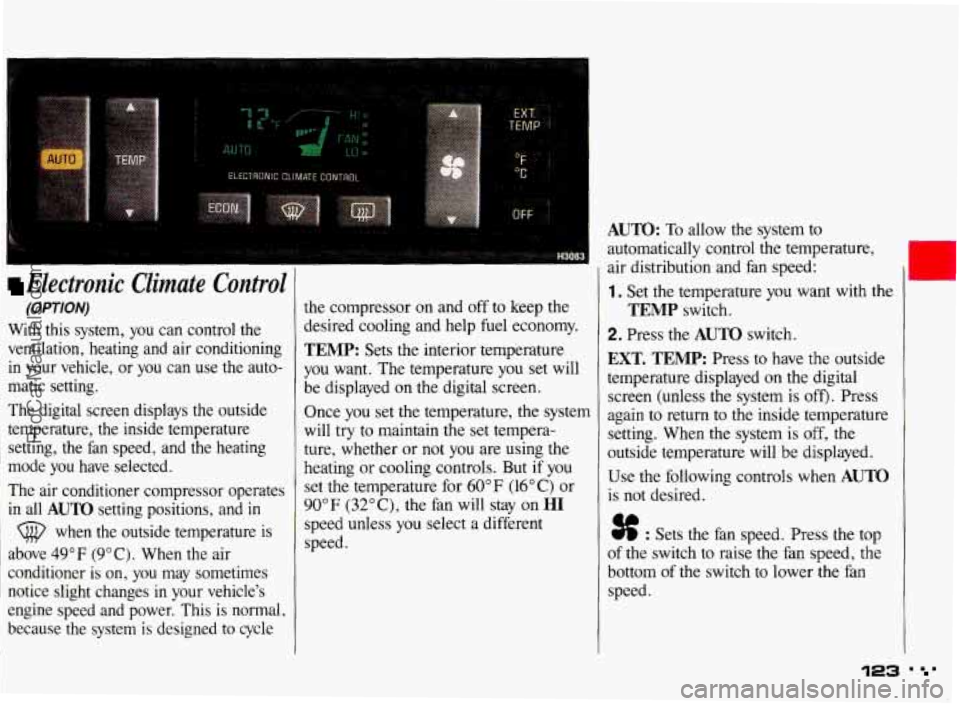
., . .. -.
Electronic Climate Control
(OPTION)
With this system, you can control the
ventilation, heating and air conditioning
in your vehicle, or you can use the auto-
matic setting.
The digital screen displays the outside
temperature, the inside temperature setting, the fan speed, and the heating
mode you have selected.
The air conditioner compressor operates
in all
AUTO setting positions, and in
(@ when the outside temperature is
above 49°F (9°C). When the air
conditioner is on, you may sometimes
notice slight changes
in your vehicle's
engine speed and power. This is normal,
because the system
is designed to cycle
the compressor on and off to keep the
desired cooling and help
fuel economy.
TEMP: Sets the interior temperature
you want. The temperature you set will
be displayed on the digital screen.
Once you set the temperature, the system
will
try to maintain the set tempera-
ture, whether or not you are using the
heating or cooling controls. But
if you
set the temperature for 60°F (16°C) or
90"
F (32" C), the fan will stay on HI
speed unless you select a different
speed.
AUTO: To allow the system to
automatically control the temperature,
air distribution and fan speed:
1. Set the temperature you want with the
2. Press the AUTO switch.
TEMP switch.
EXT. TEMP: Press to have the outside
temperature displayed on the digital
screen (unless the system is
off). Press
again to return to the inside temperature
setting. When the system is
off, the
outside temperature will be displayed.
Use the following controls when
AUTO
is not desired.
% : Sets the fan speed. Press the top
of the switch to raise the fan speed, the
bottom of the switch to lower the fan
speed.
123 ' '
ProCarManuals.com
Page 125 of 322
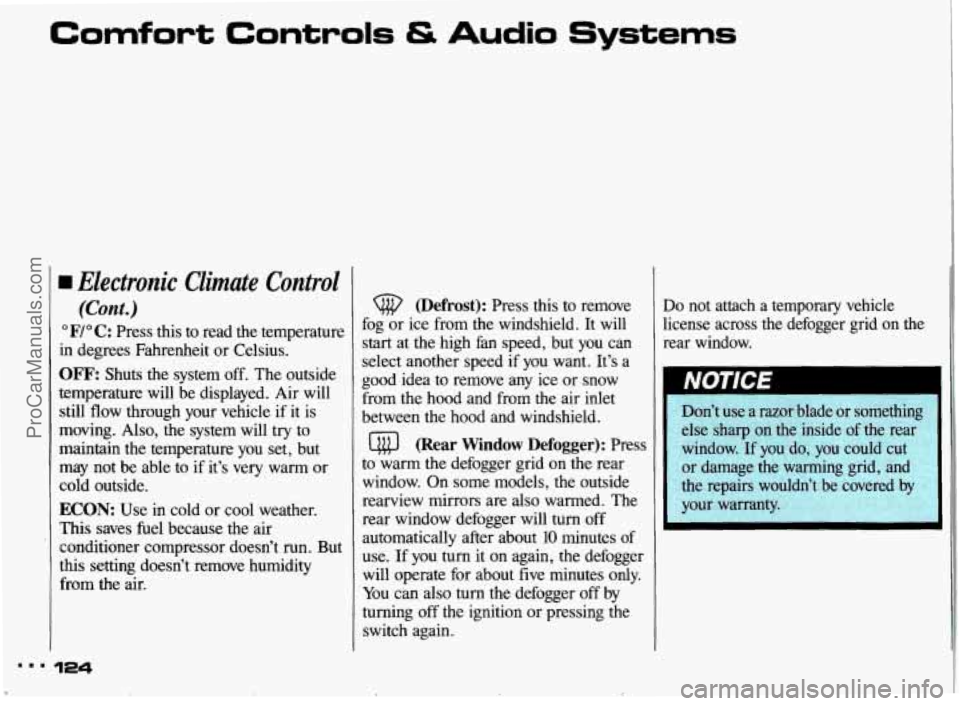
Comfort Controls & Audio Systems
Electronic Climate Control
(Cont.)
OF/” C: Press this to read the temperature
in degrees Fahrenheit or Celsius.
OFF: Shuts the system off. The outside
temperature will be displayed. Air will
still
flow through your vehicle if it is
moving. Also, the system will try to
maintain the temperature you set, but
may not be able to if it’s very warm or
cold outside.
ECON: Use in cold or cool weather.
This saves
fuel because the air
conditioner compressor doesn’t
run. But
this setting doesn’t remove humidity
from the air.
(Defrost): Press this to remove
fog or ice from the windshield. It will
start at the high fan speed, but you can
select another speed
if you want. It’s a
good idea to remove any ice or snow
from the hood and from
the air inlet
between the hood and windshield.
@ (Rear Window Defogger): Press
to warm the defogger grid
on the rear
window.
On some models, the outside
rearview mirrors are also warmed. The
rear window defogger will turn off
automatically after about
10 minutes of
use.
If you turn it on again, the defogger
will operate for about five minutes
only.
You can also turn the defogger off by
turning off the ignition or pressing the
switch again.
Do not attach a temporary vehicle
license across the defogger grid
on the
rear window.
Don’t
use a razor blade or something
else sharp on the inside
of the rear
window.
If you do, you could cut
or damage the warming grid, and
the repairs wouldn’t be covered by
your warranty.
1.1 124
ProCarManuals.com
Page 156 of 322
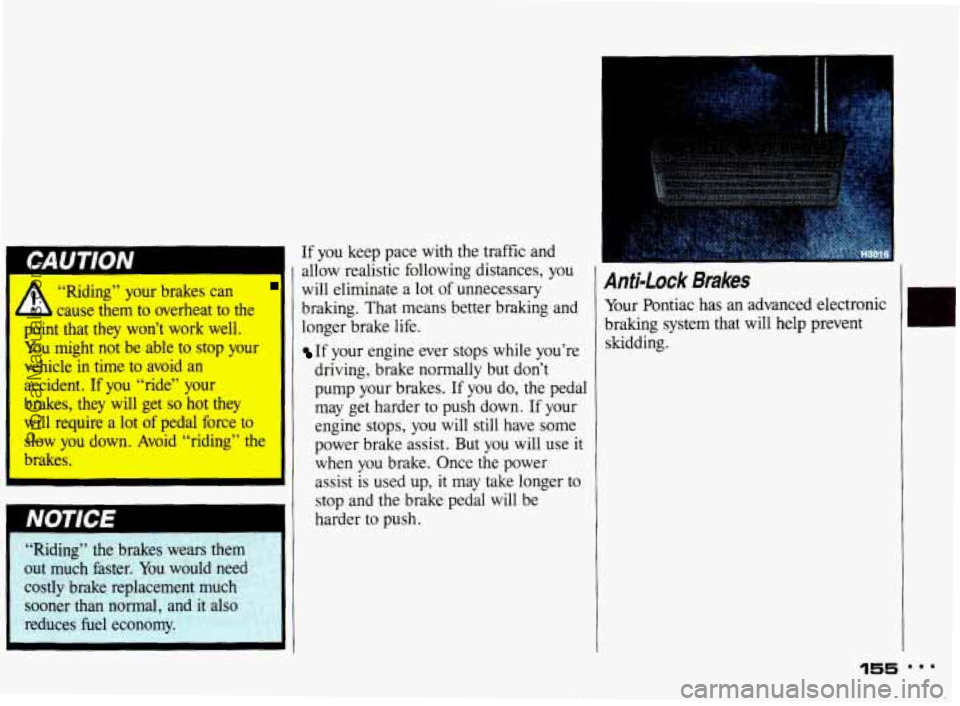
“Riding” your brakes can
1 cause them to overheat to the
point that they won’t work well.
You might not be able to stop your
vehicle in time to avoid an
accident. If you “ride” your
brakes, they will get so hot they
will require a lot of pedal force to
sIow you down. Avoid “riding” the
brakes.
’
I NOTICE I
“Riding” the brakes wears them
out much faster. You would need
costly brake replacement much sooner than normal, and
it also
reduces fuel economy.
!
If you keep pace with the traffic and
allow realistic following distances, you
will eliminate a lot
of unnecessary
braking. That means better braking and
longer brake life.
If your engine ever stops while you’re
driving, brake normally but don’t
pump your brakes. If you do,
the pedal
may get harder to push down.
If your
engine stops, you will still have some
power brake assist. But
you will use it
when you brake. Once the power
assist is used up,
it may take longer to
stop and the brake pedal will be
harder to push.
Anti-Lock Brakes
Your Pontiac has an advanced electronic
braking system that will help prevent
skidding.
ProCarManuals.com